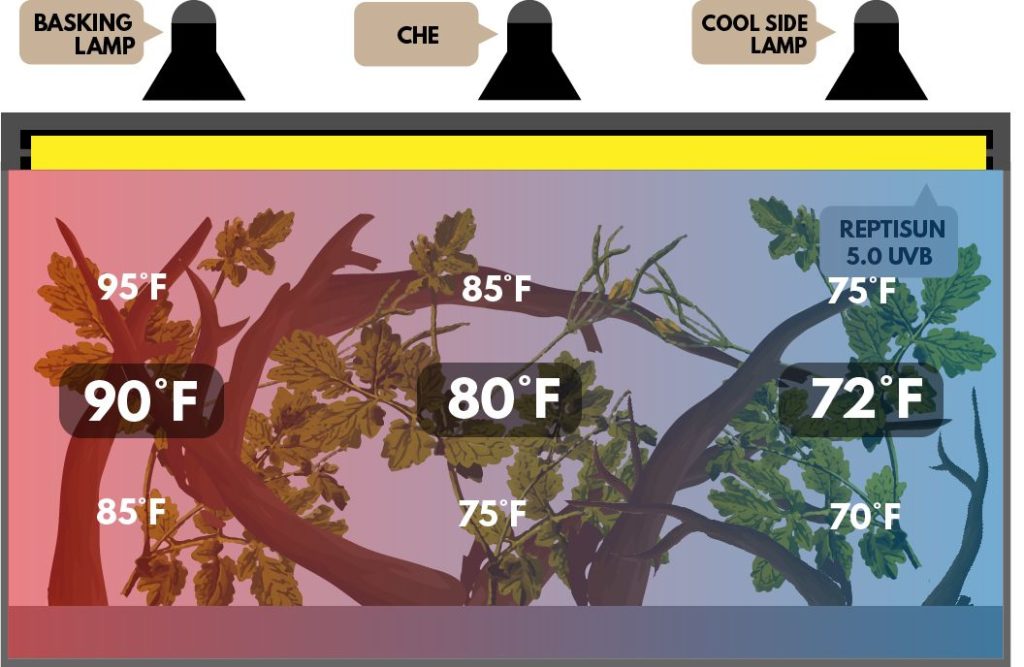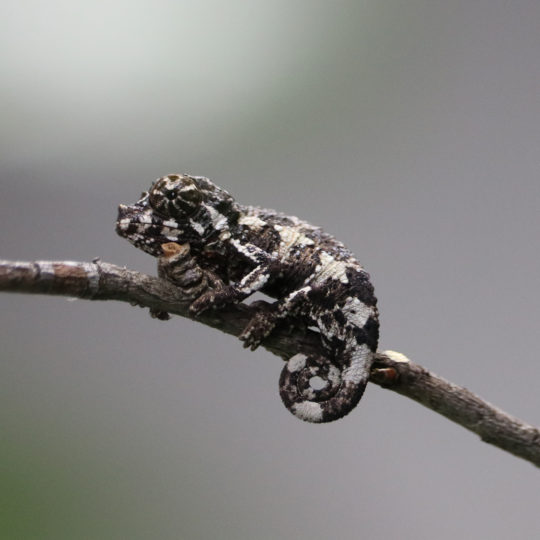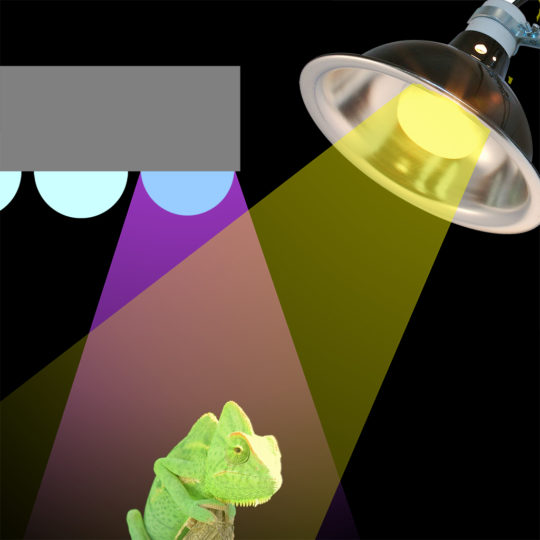Keeping your chameleon healthy and happy requires carefully regulating both light and temperature in its enclosure. While bright, warm lighting during the day is essential, what about at night? Do chameleons need special night lights or heat sources when the sun goes down? In this comprehensive guide, we’ll shed some light on chameleon nighttime care.
Why Chameleons Need Darkness at Night
In nature, chameleons experience a regular day/night cycle. When the sun sets temperatures drop and darkness ensues. This signals their bodies to slow down and prepare for sleep. Replicating this cycle in captivity is key to your chameleon’s health.
Chameleons have excellent night vision and can see the light from “night lights.” Any illumination can disrupt their circadian rhythms and prevent good sleep. Stress, health issues, and shorter lifespans can result. Simply put, chameleons need complete darkness at night.
Dangers of Using Night Lights
Well-meaning owners often use night lights because they enjoy watching their chameleon after hours or mistakenly believe they provide benefits. However, studies have shown that any exposure to artificial light at night, even dim light, negatively impacts chameleon health:
- Disrupts normal sleep-wake cycles
- Stresses the immune system
- Increases risk of obesity and metabolic disorders
- Can lead to respiratory infections and increased mortality
If ambient temperatures call for supplemental heating at night there are safe options. But night lights themselves offer no benefits and pose real risks.
Ideal Nighttime Temperatures for Chameleons
While chameleons require darkness at night, they also need adequate warmth. What are the ideal nighttime temperature ranges for different chameleon species?
- Veiled chameleons: 55°F – 65°F
- Panther chameleons: 65°F- 75°F
- Jackson’s chameleons: Around 60°F
These low to mid 60s temperatures allow their metabolism to slow for restful sleep. Monitoring your enclosure’s ambient nighttime temperatures with a digital thermometer is recommended
Providing Supplemental Heat Safely
If the ambient temperature drops excessively at night, supplemental heating may be needed. But take care to avoid lights that disturb sleep:
- Ceramic heat emitters: Emit infrared heat but no visible light.
- Space heaters: Warm the entire room instead of just the enclosure.
- Insulation: Cover part of the enclosure with a towel or blankets.
Aim to raise temperatures just enough for your chameleon’s comfort and health. Allow some natural overnight temperature drop to initiate sleep.
Setting an Automated Day/Night Lighting Schedule
Establishing a consistent daily light/dark schedule is crucial. Chameleons thrive on predictability. Here are some tips:
- Provide 12 hours of bright, warm daytime light. Turn off at night.
- Use an automatic timer to maintain the schedule.
- Mimic daylight hours, like 6:30am to 6:30pm.
- Provide a period of dimming light at “dusk” before full darkness.
- Ensure zero light pollution or illumination at night.
With a proper photoperiod and temperatures, your chameleon can flourish in captivity as they would in the wild.
Night Light Alternatives: Safely Observing Your Chameleon
We know you want to watch your beloved chameleon, even after bedtime. Consider these safe night viewing options:
- Webcams: Position an infrared camera inside the enclosure. View remotely.
- Glow-in-the-dark furnishings: Add glow elements to track movements.
- Periodic checks: Briefly shine a flashlight when absolutely needed.
Any observation should be brief and infrequent to avoid sleep disruption. The health risks simply aren’t worth it.
FAQs: Chameleon Lighting and Temperature Needs
Let’s review some frequently asked questions about lighting and heating for chameleons:
Do chameleons need special UVB or heat lamps at night?
No special lighting is required at night. Chameleons need complete darkness to sleep soundly.
What temperature should my chameleon’s enclosure be at night?
Ideally, temperatures should drop 10-15°F from daytime, ranging from 55-75°F depending on species.
How can I safely warm my chameleon’s enclosure at night?
Use a ceramic heat emitter, space heater, or insulate the enclosure. Avoid lights.
Can I use a red or blue night light for my chameleon?
No, chameleons can still see these colored “night” lights. Complete darkness is best.
Is it okay if my chameleon’s enclosure gets below 60°F at night?
Temperatures below 60°F can be unsafe. Supplemental heating may be needed.
Why does my chameleon need a day/night cycle?
The light/dark cycle regulates their circadian rhythms for optimal health.
How many hours of light per day should my chameleon get?
Provide 12-14 hours of bright, uninterrupted daylight. Keep nights dark.
Do different chameleon species have different lighting needs?
Temperature and lighting needs differ somewhat between species. Research accordingly.
Create the Ideal Chameleon Habitat
Caring for a chameleon requires diligently replicating their natural environment – including proper day and nighttime temperatures. By providing warm, bright days and cooler, dark nights, you can keep your pet healthy and content. Avoid night lights, use timers, and supplement heat safely when needed. With some planning and the right habitat, your chameleon can thrive in captivity.

Why heat is important

Chameleons are ectothermic, or “cold-blooded”, meaning that they do not produce their own heat. Their body is designed to rise and fall with the outside temperature. But they still need to be within certain temperature ranges for their body to properly function so they will move to find sun and then retreat to the leaves be protected from the sun. We need to replicate this in our captive husbandry. Through the use of a basking light we simulate the sun. Through the use of dense plant cover we simulate the shade. And thus we let the chameleon decide what they need to get to the proper temperature.
Each chameleon species will have different temperature requirements and it is critical that you understand what is needed by each species. It is even important to provide a cool down at night for a number of species. We think of anything that looks exotic as having come from a steamy Tarzan jungle. While tropical chameleons do exist, an enormous number of species come from high elevations where they need mild temperatures and a significant night time drop in temperature. The infamous Jackson’s Chameleon “sudden death syndrome” where they suddenly drop dead has an unknown cause, but a likely scenario is physical exhaustion. Without the nighttime drops, their body does not get the sleep it needs. The body slowly exhausts itself and then just gives out. We are still investigating this particular situation, but giving your chameleon both the heat – and cold – that it has developed to require is part of the recipe for success.
Positioning your heat lamp

Your ideal situation is where the basking lamp is heating the perching spot where the highest level of UVB is. This caters to your chameleons natural condition where light = heat = UVB. If you are just placing the basking bulb on the top screen then your options to do this are limited. If you have a post or some method of mounting the basking bulb above the cage then your flexibility increases. Breeders have reported that chameleons can detect UVB and will bask under heat and then UVB so it appears our efforts to have UVB and heat together may not be necessary. I continue to experiment with both set-ups to determine if there is any difference. So, bottom line, it is your decision.
On a final note, be aware of how far your misters reach. You do not want your light bulbs to be hit with cold water from the misters or any other water source. Electricity and water do not mix with positive results and a hot bulb sprayed with water may shatter.
